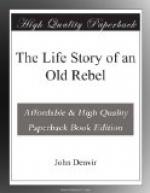By the pleasant waters of the River Lee.
and I have heard her exclaiming, I at the time believing it most implicitly:
“Sin, is it? Sure. I never heard of sin till I came to Liverpool; there’s no sin in Cor-r-k!”
And she rattled the “r” with a strong rising inflexion, greatly impressing me with the high character of Ireland and of Cork in particular.
At that time I had never seen Ireland but as an infant at my mother’s breast.
CHAPTER III.
Ireland re-visited.
I was a boy of about 12 when I first re-visited Ireland; and, as the steamer entered Carlingford Lough, which to my mind almost equals Killarney’s beauty—but that, perhaps, is a Northman’s prejudice—with the noble range of the Mourne mountains on the one side and the Carlingford Hills on the other, it seemed to my young imagination like a glimpse of fairy land.
Carlingford reminded me of what my old masters, the Christian Brothers, used to teach us, that those places ending in “ford” had at one time been Norse settlements. There is not the slightest trace, I should say, of people of Norse descent along this coast now, unless we accept the theory that would regard as such the descendants of the Norman De Courcy’s followers, who can be recognised by their names, and are still to be found, side by side, and intermingling with those of the original Celtic children of the soil in the barony of Lecale. It is astonishing, by the way, how you still find in Ireland, after centuries of successive confiscations, the old names in their old tribal lands, mingled in places, as in Lecale, with the Norman names; the two races being now thoroughly amalgamated—as distinguished from the case of King James’s Planters in Ulster, who, to this day are, as a rule, as distinct from the population amongst whom they live—whether of pure Celtic strain or with a Norman admixture—as when first they came.
There was an idea in our family that I had a vocation for the priesthood, and I was being sent to my uncle, Father Michael O’Loughlin, parish priest of Dromgoolan, County Down, who placed me in charge of Mr. Johnson, a somewhat noted classical teacher in the neighbouring little town of Castlewellan.
I have seen but little of Ireland, but during the few months I was here on this occasion I made the best use of my time. I could have had no better guide and preceptor than “Priest Mick,” as my mother used to call my uncle. I imagine that the term “Priest,” which, in the North of Ireland, was formerly so much used as a prefix to the name of the Catholic clergyman, must have arisen amongst those not of his own flock, and was probably not intended to have exactly a respectful meaning.
Father Michael sometimes came to see his relatives in Liverpool, who were very numerous. He called them the “Tribe of Brian” (his father’s name) and he made a point of visiting them all, down to the very latest arrival—indeed, I think he was the only one who knew the whole of the ramifications of “the Tribe.”




